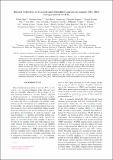Files in this item
Distinct behaviour of localized and delocalized carriers in anatase TiO2 (001) during reaction with O2
Item metadata
| dc.contributor.author | Bigi, C | |
| dc.contributor.author | Tang, Z | |
| dc.contributor.author | Pierantozzi, G | |
| dc.contributor.author | Orgiani, P | |
| dc.contributor.author | Das, P | |
| dc.contributor.author | Fujii, J | |
| dc.contributor.author | Vobornik, I | |
| dc.contributor.author | Pincelli, T | |
| dc.contributor.author | Troglia, A | |
| dc.contributor.author | Lee, T | |
| dc.contributor.author | Ciancio, R | |
| dc.contributor.author | Drazic, G | |
| dc.contributor.author | Verdini, A | |
| dc.contributor.author | Regoutz, A | |
| dc.contributor.author | King, Phil | |
| dc.contributor.author | Biswas, Deepnarayan | |
| dc.contributor.author | Rossi, G | |
| dc.contributor.author | Panaccione, G | |
| dc.contributor.author | Selloni, A | |
| dc.date.accessioned | 2020-02-28T19:30:01Z | |
| dc.date.available | 2020-02-28T19:30:01Z | |
| dc.date.issued | 2020-02-28 | |
| dc.identifier | 266359900 | |
| dc.identifier | 89934390-2213-44b8-9de5-12bad756ee18 | |
| dc.identifier | 85082794557 | |
| dc.identifier | 000517314500009 | |
| dc.identifier.citation | Bigi , C , Tang , Z , Pierantozzi , G , Orgiani , P , Das , P , Fujii , J , Vobornik , I , Pincelli , T , Troglia , A , Lee , T , Ciancio , R , Drazic , G , Verdini , A , Regoutz , A , King , P , Biswas , D , Rossi , G , Panaccione , G & Selloni , A 2020 , ' Distinct behaviour of localized and delocalized carriers in anatase TiO 2 (001) during reaction with O 2 ' , Physical Review Materials , vol. 4 , no. 2 , 025801 . https://doi.org/10.1103/PhysRevMaterials.4.025801 | en |
| dc.identifier.issn | 2475-9953 | |
| dc.identifier.uri | https://hdl.handle.net/10023/19560 | |
| dc.description.abstract | Two-dimensional (2D) metallic states induced by oxygen vacancies (VOs) at oxide surfaces and interfaces provide opportunities for the development of advanced applications, but the ability to control the behavior of these states is still limited. We used angle resolved photoelectron spectroscopy combined with density-functional theory (DFT) to study the reactivity of VO-induced states at the (001) surface of anatase TiO2, where both 2D metallic and deeper lying in-gap states (IGs) are observed. The 2D and IG states exhibit remarkably different evolutions when the surface is exposed to molecular O2: while IGs are almost completely quenched, the metallic states are only weakly affected. DFT calculations indeed show that the IGs originate from surface VOs and remain localized at the surface, where they can promptly react with O2. In contrast, the metallic states originate from subsurface vacancies whose migration to the surface for recombination with O2 is kinetically hindered on anatase TiO2 (001), thus making them much less sensitive to oxygen dosing. | |
| dc.format.extent | 9 | |
| dc.format.extent | 7506638 | |
| dc.language.iso | eng | |
| dc.relation.ispartof | Physical Review Materials | en |
| dc.subject | QC Physics | en |
| dc.subject | QD Chemistry | en |
| dc.subject | DAS | en |
| dc.subject.lcc | QC | en |
| dc.subject.lcc | QD | en |
| dc.title | Distinct behaviour of localized and delocalized carriers in anatase TiO2 (001) during reaction with O2 | en |
| dc.type | Journal article | en |
| dc.contributor.sponsor | The Royal Society | en |
| dc.contributor.institution | University of St Andrews. Centre for Designer Quantum Materials | en |
| dc.contributor.institution | University of St Andrews. School of Physics and Astronomy | en |
| dc.contributor.institution | University of St Andrews. Condensed Matter Physics | en |
| dc.identifier.doi | https://doi.org/10.1103/PhysRevMaterials.4.025801 | |
| dc.description.status | Peer reviewed | en |
| dc.identifier.grantnumber | URF/R/180026 | en |
This item appears in the following Collection(s)
Items in the St Andrews Research Repository are protected by copyright, with all rights reserved, unless otherwise indicated.

